
|
|
 |
The telltales make the trimming of the sails and the steering of the boat easier. You shouldn't stick too many telltales on your sails - when sailing, the amount of information streaming in exceeds the capacity of the crew, so keep it as simple as possible. In this article we explain which telltales are essential and sufficient at the same time. We recommend not to have more telltales than that. The telltales in the leech should be made of a rather strong nylon strip. Normally they are already installed by your sailmaker. The telltales in the luff should be of woolen yarn glued onto the sail with a colorful sticky-back.
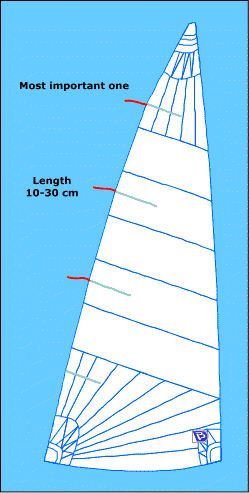
Mainsail telltails
In the mainsail telltales are only needed in the leech. Cut them out of an inch wide nylon strip and sew them into the ends of the batten pockets. The right length is from six to twelve inches. On the race course colorful strips are the best but if you are racing at night, you are better off using white telltales because they show clearly against the dark sky. That's why the telltales on offshore racers often are white.
Steering tails
The telltales near the luff of the sail are used as a steering aid when sailing upwind. If you are pointing too high the windward telltales "stall", i.e. point straight up or stream forwards or twirl around restlessly. If you are sailing too low the leeward telltales hang down and die, which is a sign of a serious steering error - the leeward telltales should always stream steadily aft. When the leeward telltales stall, the jib trimmer should ease the sheet until the helmsman is back onto his proper course again. Stalling the leeward telltales means that the whole foresail is about to stall. It then loses most of its drive and only the heeling force remains.
The windward telltales indicate different things depending of the wind strength. In light winds your heading is correct when both the windward and leeward telltales stream steadily aft. The maximum speed is achieved by steering so high that the windward telltales are just about to twirl. In medium winds the best speed is achieved when the windward telltales jump up at steady intervals. Telltale 1, telltale 2, telltale 3 - jump - telltale 1...
When the wind increases the telltales become less important as an indicator of the proper course. Steer the boat according to the heeling angle and the wave conditions and never mind the (windward) telltales.

The steering telltales are most useful when sailing upwind. Steering according to the telltales in light and medium conditions normally maximizes VMG, i.e. your speed towards the mark is the greatest. A high VMG does not necessarily mean the highest speedometer values, but indicates the ideal combination of boat speed, pointing and leeway.
Leech tails
Both the main and the jib should have two to four telltales in the leech, used to proper sheeting. The leech tails, as well as the telltales for steering, are of the most value in light to medium air. The telltale at the end of the top batten pocket is essential when adjusting the proper twist for the main sail. When the telltale disappears behind the sail, the sheet is too tight and the sail has too little twist. In a light winds (5 to 10 kn) the top telltale should be flying for about half of the time. In less than about five knots the leech tails won't work properly. When the wind picks up, the sail is flattened and all the telltales normally stream aft.
The two telltales below the top one tell us about the overall shape of the sail. When the top telltale streams steadily aft but the second one is stalling, your main is either too full in the middle and /or too flat in the top. Bending the mid-section of the mast normally helps. The stalling of the lower telltales may also indicate that your jib is sheeted too loosely, and causes the airflow to separate on the leeward side of the main. Closing the gap by moving the jib lead forward/inward or changing into a larger genoa will help.
The main sheet is the most important trimming device on your boat, and the top leech tail is the best indicator of the main sheet tension. The required tension on the main sheet depends of the boat you have; use the top leech tail when you are looking for the right trim in different condition. In less than 5 knots of wind adjust the sheet so that the upper tail is visible only sometimes. In medium air the upper tail should show itself about 50% of the time, and in heavy air all leech tails must fly constantly.
Jib leech telltales
The telltales in the leech of the genoa behave somewhat differently from the ones in the main. Never sheet your genoa so tight that all the telltales in the leech stall! Before stalling, the telltales become slow and lazy; that indicates your maximum trim. However, if your boat has a high & narrow jib, with little overlap (like on some one-designs), you may allow the leech tails to stall from time to time in a light air and medium airs. The top telltale is again the most important as it is usually the first one to react to the wrong trim. In some boats the spreaders restrict how far in the genoa can come. In these boats the top telltale may still stream aft when the middle one already stalls - ease the sheet a hair. In older jibs the leech may start to hook in and the telltales become then less reliable.
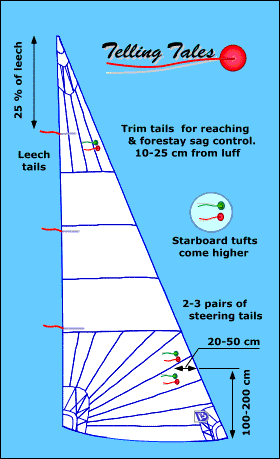
 Sticking tails on
headsails
Sticking tails on
headsails
Install the telltales at the half and quarter points down the leech. Two pairs of steering telltales should be installed in the luff of the sail approximately ten to twenty inches behind the luff rope *) and four to eight feet above the tack. In small boats the telltales should be lower and nearer to the luff than in bigger boats. Don't set the telltales at the same spot on different sides of the sail but always fix the starboard telltale an inch higher. When sailing towards the sun it may otherwise be difficult to distinguish the windward telltale from the leeward one. If you happen to forget which telltale is higher look at the mainsail numbers; they follow the same rule.
It's a good idea to have two sets of steering telltales. One set should be installed a bit higher and closer to the luff than the other. The telltales further away from the luff are more forgiving and you should steer according to them in rough seas and in heavy winds. The telltales closer to the luff are more sensitive and you should use them in smooth seas and lighter conditions.
The telltales get easily stuck - avoid installing them too close to the seams. If the lower telltales have got stuck, or if the crew is obscuring the view, you can steer by the upper set. The telltales shouldn't be installed higher than where you can reach from the foredeck, so that you can easily free them in case they get stuck. One way to release a telltale is to smack the clew - this helps to avoid the unnecessary trips to the foredeck.
The top telltale set is to be installed nearer to the luff than the steering telltales. They are mainly used when determining the right amount of twist for the jib on a reach.
*) The
correct distance from the luff depends on the sail size: stick your driving
tales at a distance of 7,5-15% of the width of the sail at the level of the
telltails.
On a reach ...
... telltales are used for trimming the sails. The helmsman steers by the compass or to a fixed point in the horizon and it is the crew's duty to keep trimming the sails so that the telltales stream steadily aft. On a reach the top telltales in a jib are of good value when determining the right twist, which is otherwise very difficult, especially with high aspect ratio jibs. If the windward top telltales are stalling, move the jib lead forward. Remember that you can rely on the telltales only in light and medium conditions. In strong winds the heel becomes the main trimming indicator and the excess power has to be released by increasing the twist. The jib trim on a reach is always a compromise between the upper and lower sections of the sail. It might be a good idea to move the jib lead all the way out to the toe rail and forward so that the windward top telltale streams steadily aft. Normally it is very difficult to get both the top and bottom telltales to work well together.
The top telltales also give an indication of the sag of the headstay. If the windward telltale wobbles all the time, the top section of the sail may be too full; try straightening the headstay. However, it is quite normal that the windward tail streams right up when it gets windy and you are overpowered.
Don't use
the luff telltales when looking for the right position for the jib lead - the
information you get is often more harmful than beneficial. You may have the lead
way back but the sheet very tight, and the telltales be streaming fine, or vice
versa. The correct jib trim is always a combination of lead position and sheet
tension, and there is no single right lead position.
| Below:
If the leeward telltales are stalling or streaming forward, you are
sailing too low. Come up a bit, or ease the jib sheet. bit, or ease the
jib sheet. In light air, steer just on the verge of collapsing the leeward
tails.
|
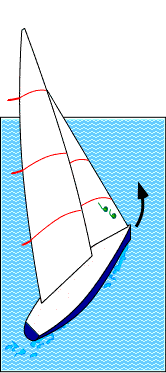
|
| Above:
If the windward telltales are continuously jumping up but the boat isn't
heeling excessively, you are sailing too high. In medium air on an ideal
heading the telltales jump up at three to four second
intervals.
In stronger winds (15 kn +) ignore the telltales and steer by the heel angle. |

When the wind sweeps past the sail its velocity near the sail surface decreases because of the friction. This so called boundary layer can be over 2 inches thick in the middle on the windward side and in the leech on the leeward side of the sail. When the velocity of the air stream decreases to a certain point the boundary layer separates from the sail. The telltales indicate how the boundary layer is behaving at different moments in different parts of the sail. The separation of the boundary layer always means a significant loss in power and is to be avoided at all cost. This is why the telltales are so useful, and why we try to trim the sail so that they always stream steadily aft.
Separation bubbles
The sail is often compared to a wing of an airplane. A sail, however, has one aerodynamic characteristic that makes the comparison feeble. In the luff of a sail the airflow always gets separated from the sail surface on one side or the other, creating a separation bubble. The thick and round leading edge of a wing - or a keel of a sailboat - eliminates the separation of the boundary layer, which improves the efficiency of the foil considerably.
| Windward side
bubble
When the airflow meets the luff of the sail in too steep an angle, it separates and a separation bubble forms. The bubble is like a small eddy where air circulates around in the same spot. The tighter the sail is sheeted the longer the separation bubble will be. The airflow reattaches to the sail behind the separation bubble. Depending on the size of the bubble and the position of the steering telltales they either stream steadily aft, twirl in a funny way or in the worst case even stream forwards against the wind. If you are pointing too high the bubble forms on the windward side of the sail. The bubble on the windward side is less harmful than the one on the leeward side; in heavy winds there is always a bubble of some length on the windward side of the sail. |
 |
| Smooth
flow
The very luff of the sail nearly always has a separation bubble on one side or the other which is why the telltales shouldn't be installed too close to the luff. When the sail is sheeted properly and the boat is on its ideal course, the telltales on both sides of the sail stream steadily aft. In this case, the separation bubble at the luff is then extremely small and alternates from one side to the other. The airflow meets the luff of the sail at an ideal angle and the flow is smooth at both sides of the sail. |
 |
| Leeward side
bubble
If you are sailing too low, or if the sail is sheeted in too hard, a separation bubble forms on the leeward side. This is very harmul to the performance and should be avoided at all times. Independently of the luff separation bubble, the airflow may get detached from the sail just before the leech on the leeward side. The eddy formed like this makes the leech telltale disappear behind the sail. For the sake of clarity, the size of the separation bubbles is exaggerated in the drawing. |
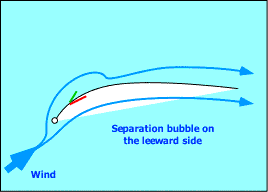 |
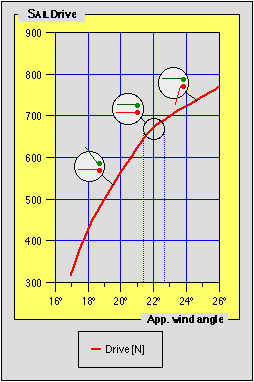
The graph on the left represents the forward force or the driving force at different apparent wind angles for a 40-footer in a light wind (AWS = 12 kn).
The driving force increases steeply until the apparent wind angle is 21¡. Until then there is a separation bubble on the windward side of the sail, which gradually disappears. The windward telltale wobbles or streams upwards and the luff of the main may backwind. The 22¡ apparent wind angle is optimal for this setting of the sails; both telltales are streaming steadily aft. This is when the driving force in relation to the heeling force is at its maximum. When bearing off further the driving force still increases, but less steeply than earlier. The airflow starts to get detached more and more on the leeward side of the sail, as shown by the stalling of the leeward telltales.
In this computer simulation only the course the boat sailed is altered while the sheeting of the sails remain the same. In a real situation the sheeting of the sails would be adjusted according to the course.
Copyright © 1995 -98 WB-Sails Ltd. Updated 7/98. All rights reserved.